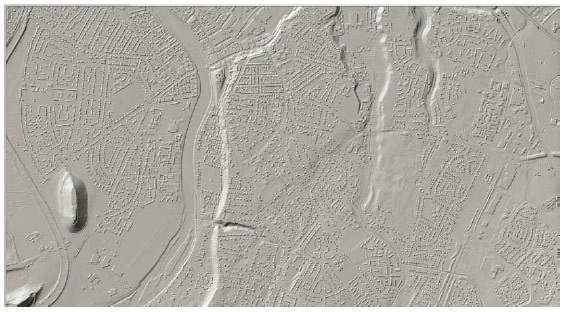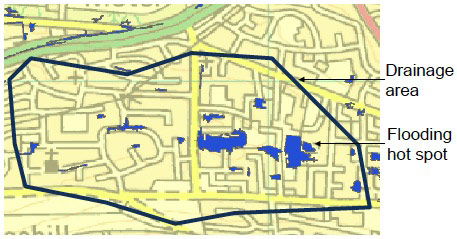Surface water management planning: guidance (2013)
Guidance to assist the responsible authorities in preparation of Surface Water Management Plans (SWMPs) to help with the management of surface water flooding. This guidance has now been superseded by the 2018 edition.
Appendix 3 - Principles of modelling surface water flooding
We use modelling tools to predict the location, likelihood and impact of surface water flooding. Because surface water flooding is not a regular occurrence which can be understood fully through observation, predictive models help us understand where flooding could occur if there was heavy rain in that location and how this might change with climate change and help test the effectiveness of measures to manage the risk of surface water flooding. Detailed mapping information is used to understand the types of building or infrastructure that will be affected by the flood.
Most surface water flooding models apply design rainfall profiles of a known likelihood (return period) to a digital terrain model ( DTM) of the landscape (Figure 1). The rainfall is converted into runoff at a rate depending on the land use type (rural or urban) and then routed along flow pathways (e.g. sloping streets) to low points where it may pond. Through examining the maximum extent and depth of flooding at each point in the modelled area we can determine the homes, businesses and infrastructure which are likely to be exposed to flooding. Over urban areas, a portion of the rainfall input is completely removed to account for the role that urban drainage systems have in removing water from an area. Much of the remaining runoff is routed in the model to natural river channels but a portion cannot reach these 'sinks' in the system and the model indicates where this residual amount may result in flooding. The model is further enhanced by the representation of buildings which are added to the terrain model. Buildings act to control the direction of flows through urban areas.

Figure A1 - Representation of the ground is a key component of surface water flood modelling. The example above is a Digital Terrain Model ( DTM) produced from LiDAR data with buildings represented.
In some circumstances the complex interaction of sewer systems, watercourses and overland flows mean that the simplified modelling approach described above is inadequate and models inaccurately predict flooding and therefore cannot be used to help design robust solutions. In these circumstances a more detailed modelling approach can be used which includes explicit representation of the sewer system and watercourses which act as important conveyors of surface water underground and through towns and cities. These more detailed models (sometimes referred to as integrated urban drainage models or integrated catchment models) are time consuming and costly to prepare and require the collaboration of different organisations. Their use is therefore reserved for areas of highest risk and only where complex flooding mechanisms exist.
The types of modelling used to examine surface water flooding and the operation of integrated urban drainage systems is described more fully in section C of the CIWEM Urban Drainage Group's guide to Integrated Urban Drainage Modelling (2009). The guide provides advice on where more detailed modelling approaches are warranted.
Once a robust model that predicts the surface water flood hazard has been developed the consequences of that flooding are then assessed to identify flood risk. Flood risk is calculated in the same way for simple and more complicated models. Multiple simulations of events for different likelihoods are used to estimate the consequences of flooding on human health, the environment, cultural heritage and economic activity. The Ministerial Guidance on SFM states that when assessing the consequences of flooding the following factors should be taken into account:
- Exposure - what will be exposed to the flood
- Vulnerability - can be assessed as a factor of susceptibility (the propensity of a receptor to suffer harm from flooding) and resilience (the ability of a receptor to recover from damage incurred as a result of flooding)
- Value - the value of things exposed to the hazard, which could include costs or how critical the item is.
To support a risk based approach to the assessment and management of surface water flooding and to determine where effort should be focused (this may include focus for certain measures e.g. structural measures, awareness raising or further modelling) drainage areas or flooding 'hot spots' should be identified. 'Hot spots' are concentrations of localised flooding (e.g. street or neighbourhood scale) which most likely have a single or linked cause. The area influencing the hot spot, that covers the main sources and pathways of surface water to the hot spot, is called a 'drainage area'. Drainage areas can be defined through examining the topography and underground drainage connections; it is the zone of influence for the flooding hot spot and the region within which measures to reduce the likelihood of flooding are most likely to be implemented. The flood consequences across different hot spots and drainage areas can be compared.

Figure A2 - Indicative example of a surface water flooding 'hot spot' and its associated drainage area.
Contact
There is a problem
Thanks for your feedback